Web Infantry Equipment, Pattern 1944
Equipment and Equipment Carriers: Basic Pouches
Stores Ref. A6/AF 0266 Pouch, basic, left, W.E. Patt. ‘44
Stores Ref. A1/AA 2011 Pouch, basic, left, W.E. Patt. ‘44
Stores Ref. CN/AA 2011 Web Equipment Patt. ’44, Pouch, basic, left



 The complaints about Patt. ’37 Basic pouches were addressed in Patt. ’44, whose pouches were of a larger cross-section, were deeper and closed off by a deeper, more weatherproof, box-lid, secured by a QR fastener. The form of this was new, the usual Staple being fitted to the lid, but the closure strap, stitched only at its centre part, had a link at upper and lower ends. Usually the lower end was folded up over the edge of the lid and onto the Staple. If greater capacity was needed, the upper link was used. The rear face carried the usual “C” clips and a 4-bar buckle on a web chape / fairlead. At the rear top there were two vertical loops, through which the Haversack waist strap could be threaded. Viewed from the front, the Pouch’s right side, i.e. under the arm, was fitted with an eyeleted scabbard loop, with a second lower loop for the scabbard tip. This example is maker marked "M.E. Co." and dated 1945. It is shown with a late pattern Bayonet, No. 5 Mk. I, in scabbard, fitted in its scabbard loops. From the David Gordon Collection. Photos © David Gordon 2009.
The complaints about Patt. ’37 Basic pouches were addressed in Patt. ’44, whose pouches were of a larger cross-section, were deeper and closed off by a deeper, more weatherproof, box-lid, secured by a QR fastener. The form of this was new, the usual Staple being fitted to the lid, but the closure strap, stitched only at its centre part, had a link at upper and lower ends. Usually the lower end was folded up over the edge of the lid and onto the Staple. If greater capacity was needed, the upper link was used. The rear face carried the usual “C” clips and a 4-bar buckle on a web chape / fairlead. At the rear top there were two vertical loops, through which the Haversack waist strap could be threaded. Viewed from the front, the Pouch’s right side, i.e. under the arm, was fitted with an eyeleted scabbard loop, with a second lower loop for the scabbard tip. This example is maker marked "M.E. Co." and dated 1945. It is shown with a late pattern Bayonet, No. 5 Mk. I, in scabbard, fitted in its scabbard loops. From the David Gordon Collection. Photos © David Gordon 2009.
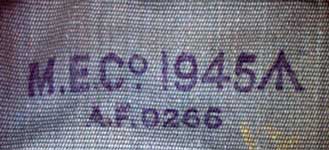 Stamping detail from the Pouch shown above, inside the lid.
Stamping detail from the Pouch shown above, inside the lid.
There was also a second version of the Pouch, basic, left. That Pouch is detailed on the NATO (CN coded Equipment) page.
Stores Ref. A6/AF 0267 Pouch, basic, right, W.E. Patt. ‘44
Stores Ref. A1/AA 2012 Pouch, basic, right,, W.E. Patt. ‘44
Stores Ref. CN/AA 2012 Web Equipment Patt. ’44, Pouch, basic, right



 This was identical to the left pouch, but without scabbard loops. This example is maker marked "M.E. Co." and dated 1945. From the David Gordon Collection. Photos © David Gordon 2009.
This was identical to the left pouch, but without scabbard loops. This example is maker marked "M.E. Co." and dated 1945. From the David Gordon Collection. Photos © David Gordon 2009.
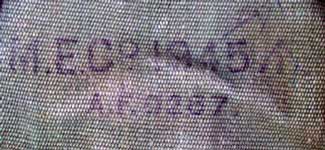 Stamping detail from the Pouch shown above, inside the lid.
Stamping detail from the Pouch shown above, inside the lid.
There was also a second version of the Pouch, basic, right. That Pouch is detailed on the NATO (CN coded Equipment) page.
Stores Ref. A6/AF 0270 Pouch, basic, M.T. drivers, W.E. Patt. ‘44
Stores Ref. A1/AA 2013 Pouch, basic, M.T. drivers, W.E. Patt. ‘44
Stores Ref. CN/AA 2013 Web Equipment Patt. ’44, Pouch, basic, M.T. drivers



 For alphabetically arranged components, the code, AF 0270 ought to have been 0268, so it suggests that the M.T. pouch was, like Patt. ’37 W.E., an afterthought. It was identical to the left hand Basic pouch, complete with scabbard loops, but its rear face had just a single belt loop in 2 inch webbing. This allowed the Pouch to be easily slid round on the Belt, on sitting Motor Transport (M.T.) drivers. This example, from the Karkee Web Collection, is maker marked "Finnigan's Ltd" and dated 1954.
For alphabetically arranged components, the code, AF 0270 ought to have been 0268, so it suggests that the M.T. pouch was, like Patt. ’37 W.E., an afterthought. It was identical to the left hand Basic pouch, complete with scabbard loops, but its rear face had just a single belt loop in 2 inch webbing. This allowed the Pouch to be easily slid round on the Belt, on sitting Motor Transport (M.T.) drivers. This example, from the Karkee Web Collection, is maker marked "Finnigan's Ltd" and dated 1954.
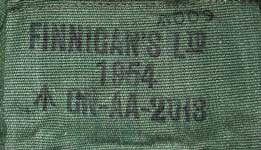 Stamping detail from the Pouch shown above, inside the lid.
Stamping detail from the Pouch shown above, inside the lid.
Stores Code None POUCH, MAGAZINES, M-1 CARBINE (Local Pattern)
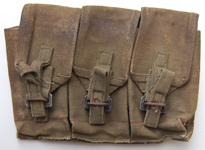
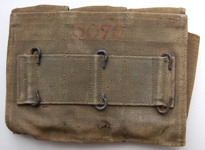
![]() The U.S. 0.30 M-1 Carbine was formerly an item in the U.K. inventory, usually seen in the Far East. There was no specific Pouch issued for its magazines, but this un-marked Local Pattern was part of a sack of webbing pouches offered to an S.F. group in Malaya.
The U.S. 0.30 M-1 Carbine was formerly an item in the U.K. inventory, usually seen in the Far East. There was no specific Pouch issued for its magazines, but this un-marked Local Pattern was part of a sack of webbing pouches offered to an S.F. group in Malaya.
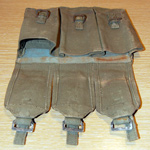
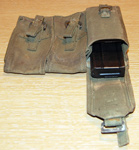 The Pouch is well-made and comprised a common backing piece of fine-woven canvas, with all four cut edges turned under and stitched. A single piece of canvas is folded into three bellows pockets and stitched into place, again with all cut edges turned under. The pockets have Patt. ’44 black anodised QR Fasteners, the tabs and chapes in Patt. ’44 lightweight webbing. The pocket flaps were separately formed, with cut edges folded under twice, elsewhere it is only necessary to fold once. The flaps were pointed by folding outwards, with the QRF stitched over the folds. The flaps were stitched inside the pockets, the junction concealed by a length of light-green twilled tape. The reverse has a strip of selvedged, 2-inch wide canvas, which fixes three properly formed “C” hooks in place. Each pocket took a pair of 15 round magazines. From the R.J. Dennis Collection. Photos (C) R.J. Dennis, 2013. Magazine by courtesy of Terry Hawker.
The Pouch is well-made and comprised a common backing piece of fine-woven canvas, with all four cut edges turned under and stitched. A single piece of canvas is folded into three bellows pockets and stitched into place, again with all cut edges turned under. The pockets have Patt. ’44 black anodised QR Fasteners, the tabs and chapes in Patt. ’44 lightweight webbing. The pocket flaps were separately formed, with cut edges folded under twice, elsewhere it is only necessary to fold once. The flaps were pointed by folding outwards, with the QRF stitched over the folds. The flaps were stitched inside the pockets, the junction concealed by a length of light-green twilled tape. The reverse has a strip of selvedged, 2-inch wide canvas, which fixes three properly formed “C” hooks in place. Each pocket took a pair of 15 round magazines. From the R.J. Dennis Collection. Photos (C) R.J. Dennis, 2013. Magazine by courtesy of Terry Hawker.
Since the US M-1 Carbine saw only limited service with the British Army overseas, KWRT Terry Hawker has provided us with some photos of an example in his collection, so we can see what this Pouch was intended to support. Photos © Terry Hawker 2013.


